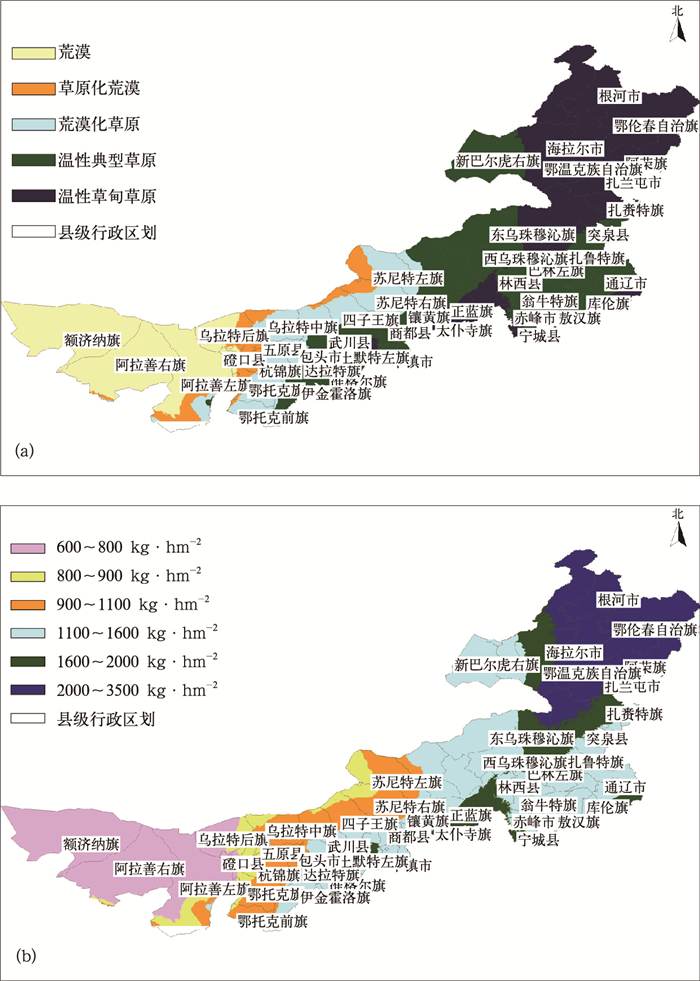Climatic Division of the Types and Yields of Grassland in Inner Mongolia
-
摘要: 根据内蒙古自治区1961—2007年107个气象站资料,利用梯度距离平方反比法,推算出内蒙古自治区湿润度的千米网格数据图形。结合内蒙古实际植被类型的分布规律,确定了内蒙古5种草原类型和6个产草量等级的气候区划指标。利用得到的气候区划指标,对湿润度栅格数据进行分级,绘制了内蒙古自治区天然草原草地类型和产草量地理分布的区划图。应用2007—2009年65个野外考察样点数据和2004—2008年49个生态观测站点的数据,对气候区划结果进行了可靠性验证,分析表明:内蒙古草原类型区划结果和实际的草原类型分布具有较好的一致性,可以用于内蒙古草原气候区划。针对各分区进行评述,并提出了合理布局的对策建议,研究结果可为内蒙古自治区农业结构调整及畜牧业生产优化布局提供参考。Abstract: Based on the meteorological observation data of 107 weather stations in Inner Mongolia, mean monthly temperatures, mean monthly air humidity and annual rainfall distribution of kilometer-scale are calculated using gradient method of inverse distance square law. Taking the raster data into Ivanov moisture degree calculation formula, the moisture degree of kilometer-scale in Inner Mongolia Autonomous Region are obtained. Combined with the distribution regularity of actual vegetation types of Inner Mongolia, climate zoning index of grassland types in Inner Mongolia are identified. Five grassland types are defined in Inner Mongolia as meadow steppe, typical steppe, desert steppe, steppe desert, and desert. With the grassland type climate zoning index, partition boundaries of grass yield are determined. On the basis of output distribution in each partition, six grass yield levels of climate zoning index are obtained, which are grass yield greater than or equal to 2000, 1600—2000, 1100—1600, 900—1100, 800—900 kg·hm-2, and less than 800 kg·hm-2, respectively. And then humidity raster data could be classified by using these climate zoning indexes. After that, the zoning map of grassland type in Inner Mongolia Autonomous Region natural grassland could be drawn. In addition to that, the zoning map of geographical distribution of grass yield could also be got. Afterwards data of 65 field investigations samples as well as 49 ecological observation sites are used in a reliability test, for climate zoning results. The reliability analysis shows that division results and the distribution of actual grassland types in Inner Mongolia have good consistency, indicating that the grassland climate zoning can better reflect the spatial distribution regularity of natural grassland types. Hence, the grassland type division results can be used for climatic regionalization in Inner Mongolia grassland. Due to neglecting the soil texture, economic and other non climate factors, there is a certain error on the boundaries between the sand, grass crisscross midwest and different grassland type areas. For each district, its geographical position, climate characteristics and grassland utilization status are reviewed, and furthermore, related analysis, countermeasures and suggestions on rational distributions are given. In conclusion, the results can provide a scientific basis for adjusting agricultural structure and optimizing livestock layout in Inner Mongolia Autonomous Region.
-
Key words:
- Inner Mongolia;
- grassland types;
- grassland yields;
- climatic division
-
表 1 内蒙古草地类型气候区划指标
Table 1 The climate division index of grassland types in Inner Mongolia
草地类型 温性荒漠 温性草原荒漠 荒漠化草原 温性典型草原 温性草甸草原 区划指标(K) 0~0.1 0.1~0.13 0.13~0.25 0.25~0.47 0.47~1.755 表 2 草地产草量气候区划指标
Table 2 The climatic regionalization index of grassland yields in Inner Mongolia
类型 大样条产草量
/(kg·hm-2)围封草地产草量
/(kg·hm-2)湿润度 林间草甸草原 ≥2000 ≥2000 ≥0.65 温性草甸草原 1600~2000 1600~2000 0.47~0.65 温性草原 1100~1600 1100~1600 0.25~0.47 温性荒漠化草原 800~1100 900~1100 0.13~0.25 温性草原化荒漠 600~800 800~900 0.1~0.13 温性荒漠 <600 <800 <0.1 表 3 草地类型区划结果与考察样点对比结果
Table 3 Climatic regionalization results for grassland types contrast with the data of fieldwork samples
草地类型 纬度 经度 优势牧草 草地类型亚类 草甸草原 49.36°N 118.84°E 贝加尔针茅 贝加尔针茅,杂类草草原 49.30°N 119.34°E 扁蓿豆,苔草 杂类草,苔草林缘草甸 49.07°N 119.71°E 羊草,贝加尔针茅 羊草,中生杂类草草甸草原 49.43°N 119.75°E 贝加尔针茅,羊草 贝加尔针茅,杂类草草原 典型草原 48.68°N 117.84°E 克氏针茅,冷蒿 克氏针茅草原 48.57°N 116.95°E 克氏针茅,狭叶锦鸡儿 克氏针茅草原 45.42°N 117.58°E 羊草,针茅 羊草,丛生禾草草原 44.13°N 116.33°E 大针茅,隐子草 大针茅草原 43.98°N 114.85°E 羊草,冷蒿 羊草,丛生禾草草原 43.73°N 120.37°E 隐子草,狗尾,冷蒿 隐子草,冷蒿退化草原 43.76°N 119.12°E 羊草,大针茅 大针茅草原 42.45°N 115.43°E 羊草,大针茅,克氏针茅 羊草,丛生禾草草原 41.78°N 111.82°E 克氏针茅,短花针茅 克氏针茅草原 39.80°N 110.26°E 大针茅,羊草 大针茅草原 荒漠草原 43.81°N 113.44°E 小针茅,无芒隐子草 小针茅,无芒隐子草,荒漠草原 42.87°N 112.56°E 小针茅,无芒隐子草 小针茅,无芒隐子草,荒漠草原 39.58°N 107.72°E 短花针茅,无芒隐子草 小针茅,无芒隐子草,荒漠草原 草原化荒漠 41.93°N 108.13°E 毛头刺,小针茅 毛头刺,草原化荒漠 40.25°N 107.13°E 霸王,松叶猪毛菜 霸王,草原化荒漠 荒漠 41.36°N 98.18°E 红砂,泡泡刺 戈壁荒漠 表 4 产草量区划结果与实测资料对比结果
Table 4 Climatic regionalization results for grassland yields contrast with the data of grassland observations
观测站点 区划产草量
/(kg·hm-2)实测产草量
/(kg·hm-2)区划草地类型 陈旗 2000~3500 2713.6 草甸草原 鄂温克 2000~3500 3331.6 草甸草原 东乌旗 1600~2000 2072.2 草甸草原 阿巴嘎旗 1100~1600 1558.4 典型草原 丰镇 1100~1600 1706.2 典型草原 新巴尔虎右旗 1100~1600 1176.8 典型草原 苏尼特右旗 900~1100 1091.8 荒漠草原 乌海市 600~800 563.4 荒漠 乌拉特后旗 600~800 426.75 荒漠 -
[1] 湖春.内蒙古自治区农牧林业气候资源.呼和浩特:内蒙古人民出版社, 1984:1-21. [2] 内蒙古自治区农牧业区划委员会办公室.内蒙古自治区农牧业资源区划数据汇编.北京:中国计划出版社, 1991:40-41. [3] 刘兴元, 梁天刚, 龙瑞军, 等.北方牧区草地资源分类经营机制与可持续发展.生态学报, 2009, 29(11):51-59. http://www.cnki.com.cn/Article/CJFDTOTAL-STXB200911013.htm [4] 谢高地, 张钇锂, 鲁春霞, 等.中国资源草地生态系统服务价值.自然资源学报, 2001, 16(1): 47-53. doi: 10.11849/zrzyxb.2001.01.008 [5] 韩同林, 林景星, 王永.京津地区"沙尘暴"的性质和治理.地质通报, 2007, 26(2):117. http://www.cnki.com.cn/Article/CJFDTOTAL-ZQYD200702000.htm [6] 内蒙古草原勘察设计院.内蒙古草地资源统计资料.呼和浩特:内蒙古人民出版社, 1988. [7] 中国农业科学院草原研究所.中国北方草地畜牧业动态监测数据集, 中国北方草地畜牧业动态监测研究 (二).呼和浩特:内蒙古大学出版社, 1996. [8] 樊锦沼, 乌兰巴特尔.气象与绵羊肉生产.北京:气象出版社, 1993:8-17. [9] 祁贵明, 王发科, 王彤, 等.唐古拉山地区气候资源特征及牧业气候区划.青海科技, 2007(3):22-23. http://www.cnki.com.cn/Article/CJFDTOTAL-QKKJ200703007.htm [10] 林忠辉, 莫兴国, 李宏轩, 等.中国陆地区域气象要素的空间插值.地理学报, 2002, 57(1):47-56. doi: 10.11821/xb200201006 [11] 魏丽, 殷剑敏, 黄淑娥, 等.贵溪市植被资源遥感调查和综合气候区划.应用气象学报, 2003, 14(6):715-721. http://qikan.camscma.cn/jams/ch/reader/view_abstract.aspx?file_no=20030690&flag=1 [12] 王文辉.内蒙古气候.北京:气象出版社, 1990:183-200. http://cdmd.cnki.com.cn/Article/CDMD-10135-1014352995.htm [13] 韩锦涛, 李素清.山西省农业气候资源的综合开发与区划.中国农学通报, 2006, 22(12):267-272. doi: 10.3969/j.issn.1000-6850.2006.12.063 [14] 中国牧区畜牧气候区划科研协作组.中国牧区畜牧气候.北京:气象出版社, 1988:152-154. [15] 任福民, 史久恩.我国干旱半干旱区的降水特征分析.应用气象学报, 1995, 6(4):501-504. http://qikan.camscma.cn/jams/ch/reader/view_abstract.aspx?file_no=19950477&flag=1 [16] 陈志鹏, 朱瑞兆, 尹晓荣.中国气候数值区划的研究.应用气象学报, 1991, 2(3):271-279. http://qikan.camscma.cn/jams/ch/reader/view_abstract.aspx?file_no=19910336&flag=1 [17] 辛晓平, 张保辉, 李刚, 等. 1982—2003年中国草地生物量时空格局变化研究.自然资源学报, 2009, 24(9):82-92. http://www.cnki.com.cn/Article/CJFDTOTAL-ZRZX200909008.htm [18] 颜亮东, 张国胜, 李凤霞.我国北方牧区天然牧草产量形成的气候模式.草业科学, 2003, 20(7):8-11. http://cpfd.cnki.com.cn/Article/CPFDTOTAL-ZGQX200312003035.htm [19] 马兴祥, 邓振镛, 李栋梁, 等.甘肃省春小麦生态气候适宜度在适生种植区划中的应用.应用气象学报, 2005, 16(6):820-827. http://qikan.camscma.cn/jams/ch/reader/view_abstract.aspx?file_no=200506108&flag=1 [20] 冯国钧, 魏绍成, 额尔敦.呼伦贝尔盟草地区划.草业科学, 1993, 10(1):36-40;43. http://www.cnki.com.cn/Article/CJFDTOTAL-NMCY4Z1.000.htm [21] 马庆文, 杨尚明, 赵金花.锡林郭勒草地农业区划.内蒙古草业, 1997, 9(4):26. http://www.cnki.com.cn/Article/CJFDTOTAL-NMCY199704008.htm [22] 蒋高明.浑善达克沙地退化生态系统恢复的对策.中国科技论坛, 2002, 3(10):13-15. http://cdmd.cnki.com.cn/Article/CDMD-80105-2006044971.htm [23] 朝洛蒙, 巴特尔.锡林郭勒草原旅游资源开发与可持续发展.干旱区资源与环境, 2004, 18(3):18-22. http://www.cnki.com.cn/Article/CJFDTOTAL-GHZH2004S3004.htm [24] 李红梅.从生态学的观点认识内蒙古草原荒漠化及其保护对策.前沿, 2008, 1:162-164. doi: 10.3969/j.issn.1009-8267.2008.01.047 [25] 贺丽娜, 康慕谊, 徐广才.锡林郭勒盟生态经济类型区划分及可持续发展研究.北京师范大学学报, 2009, 45(3):307-313. http://www.cnki.com.cn/Article/CJFDTOTAL-BSDZ200903020.htm [26] 侯春玲, 陈善科.阿拉善荒漠草场退化沙化及其治理对策的探讨.草业科学, 1994, 11(3):9-11. http://www.cnki.com.cn/Article/CJFDTOTAL-CYKX403.002.htm [27] 吴学宏, 曹艳芳, 陈素华.内蒙古草原生态环境的变化及其对气候因子的动态响应.华北农学报, 2005, 20(专辑):65-68. http://www.cnki.com.cn/Article/CJFDTOTAL-HBNB2005S1017.htm [28] 何燕, 李政, 廖雪萍.基于GIS的巴西陆稻IAPAR-9种植气候区划研究.应用气象学报, 2007, 18(2):219-224. http://qikan.camscma.cn/jams/ch/reader/view_abstract.aspx?file_no=20070237&flag=1 -


 设为首页
设为首页 加入收藏
加入收藏



 下载:
下载:
